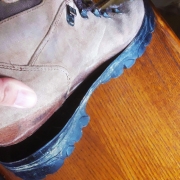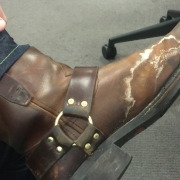Safety Boots and how the sole is attached
An excellent question as there are many misconceptions about the sole of the shoe or boot being stuck on, glued on or stitched on. All of these processes are accurate for different types of fashion footwear, dress shoes, running shoes, sneakers and even veldskoen.
What is the PU injection process for safety boots?
Polyurethane injected footwear is injected as a liquid around the leather upper which is secured in a stainless steel footwear mould (shape and design of the sole pattern). The leather upper is already in the shape of a shoe or boot at this stage – with a fake plastic foot (called a last) holding the leather designed upper in place.
How does the hot liquid polyurethane bond to the leather upper?
In order for this hot liquid polyurethane to bond to the upper – it needs something to which to attach itself. In times past, this was done by hand – in some places in the world, it is still. But modern machinery enables a robot to perform the task of roughening the leather upper to expose the leather fibres just below the surface of the animal skin. These fibres are the those most important part of the process. The robotic arm, with an object referred to as a “roughening ball” attached to the end of its “hand” is programmed to lower the ball close enough to the upper; with enough pressure to remove the top surface layer (exposing those all import fibres) but not too deeply as to cut right through the leather upper. (Meaning not to slice right through the full thickness of the leather upper). It is a fairly intricate part of the process and very technical and detailed. Precision is key.
Roughening the leather for your safety boots
The robot is pre-programmed to understand it’s mission and course. It will have to roughen around the entire outer edge of the leather upper (toe, side, heel, side and back to the toe). It is also able to detect whether the leather is harder or softer, and knows the general thickness of the leather upper it is cutting. Parameters are changed depending on the style being roughened. This enables an accurate procedure. Once completed, a full outer edge of ‘just under the surface’ leather fibres are waiting to bond themselves to hot polyurethane liquid. They will essentially absorb some of this hot liquid, whilst the balance attaches to the exposed area. Once cooled – the bond integrity is absolutely superb. Offering a super strong bond and comfortable flexing.
What else do I need to know about this roughening process?
On the odd occasion, a roughening ball coming to the end of its lifespan (becoming too blunt) – and please note these are changed a few times a week (every couple of thousand of pairs) – can under-roughen a few pairs. This results in the PU coming loose from the leather upper after a few days of wearing. On the other end of the spectrum, a brand new roughening ball, which is super sharp can cut through a piece of soft leather – sometimes too far, perhaps 80-90% of the way through. This is called over-roughening and results in a perforation line sitting where the upper and PU meet. After wearing for a day or two the leather perforates along that line creating a perfect horizontal cut in the leather. Unfortunately, neither over or under roughening can be picked up in the quality control process due to the nature of the bond and leather being a natural product. But it is isolated and generally results in happening to maybe 5 out of 5000 pairs. Processes are getting better and robots are getting more modern. Many can now detect when the ball needs to be replaced. We see fewer cases as technology gets better.
How do I spot over-roughening and under-roughening on my safety boots?
As manufacturers we can see it very easily, and our Certified Partners receive training on how to identify these manufacturing related faults. A perfectly new boot or shoe, worn for a few days – easily shows one or the other roughening issue. It happens almost 99% of the time at the flex point of the boot or shoe – where your foot naturally bends the product when walking. When the PU pulls away from the leather and creates a small gap – you can either feel with your finger that the leather is totally smooth or visually see the areas in not roughened enough. This is clear under roughening. Often, the boot can still be worn without incident – but if the PU continues to pull away further, it can be returned for a new pair. And likewise, when a perfect 1-3cm perforation line forms on the PU/leather join after flexing – the leather perforates and creates a cut. It is neat, almost looks to be cut by a knife. This is clear over-roughening. Again – the pair can be replaced.
For a chat about your work forces safety boot requirements please give us a call on +27 11 892 8030 / 8031 / 8032 or drop an email to organise a call info@profitfootwear.co.za.













